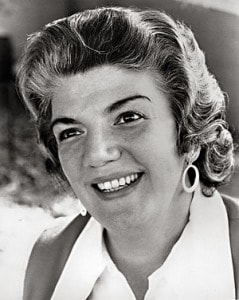
At 18 years old, she was the Broadway chorus girl Marian Saunders, appearing in Oklahoma! It was the mid-1940s, and she, like so many bright and talented young people, was drawn to the glamour of the stage. Bells Are Ringing and Guys and Dolls followed. With her strong Mexican/Argentine features, she was an impressive figure, but certainly not the common girl next door. It was a struggle. Well, how about a stand-up comedy routine? Later, Marge Cameron peeked through and created a nightclub act as the funny lady. And so it went, until she finally declared to the world: “Take me or leave me as I am!” And Carmen Zapata emerged from behind the anglicized mask that she and so many other actors had felt compelled to wear as they maneuvered through the slippery slope of an acting career.
Raised in New York City during the Depression, Carmen faced an uphill battle. Leave me as I am? Well, that didn’t happen. She worked a lot, in dozens upon dozens of television and film projects—but television and film took her as who they thought she was: a woman who represented a marginalized population. Nonetheless, there were memorable moments. Who among of us of a certain age can forget her stint on “Villa Alegre”? For her and for us, it was a put-your-hands-together moment of delight.
However, for Carmen, it wasn’t over until it was over. She met a dynamic Cuban-born director named Margarita Galban. Margarita proposed that she act in a Spanish-language play. Carmen did not speak Spanish (as is the case of so many of us born in the United States). No problem. The character is drunk most of the time. No one will even notice. And with that, she discovered the power of simply being herself. And, in tandem with Margarita and Estela Scarlata, in 1973 she co-founded the Bilingual Foundation for the Arts (and funded it out of her own pocket until the organization was more established). If the roles weren’t there for her or for us, Carmen created a safe haven for all of us to explore the power of who we are by being able to play characters drawn from the Spanish classics or Latin American play canon.
As the company developed, it made a concerted effort to produce shows in both English and Spanish. Those who made their way to Los Angeles following the same dream Carmen had dreamt worked at Bilingual Foundation for the Arts: Jimmy Smits, Tony Plana, Andy García, Zilah Mendoza (who appeared on a 2005 cover of American Theatre), and recent TCG Fox Fellow Evelina Fernandez—all were on that small stage in Lincoln Heights at an old city jail converted into an intimate theatre that represented our world. (Even this currently unemployed actress, who is now president of the TCG board, acted at Bilingual Foundation in Young Lady from Tacna—in English, of course, because like Carmen her Spanish was “not so good.”)
Whereas Carmen had no one paving the way for her, we had Ms. Zapata as our beacon, representing our struggles and finding a way to overcome them—not by waiting for someone to call, but by taking our careers into our own hands and creating them on our own.
Carmen Zapata, trail-blazer, veteran actor, singer, dancer and activist, passed away on a sunny, warm winter’s day in Southern California this past January. She will be both missed and remembered for what she left behind—a voice that will forever ring in our collective consciousness.
If the door is closed, go around it and find another. If none are open, build one yourself and invite others through. Si, se puede. Onward.
Director and writer Diane Rodriguez is currently president of the TCG board of directors.

